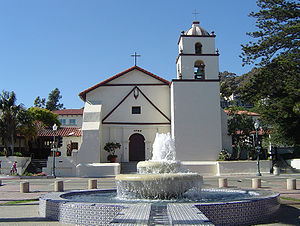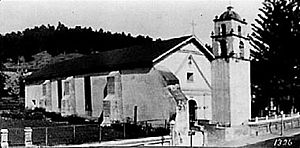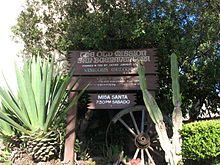- Mission San Buenaventura
-
Mission San Buenaventura 
An exterior view of the restored chapel at Mission San Buenaventura in July, 2005.Location 211 East Main Street
Ventura, CA 93001Name as founded La Misión San Buenaventura[1] English translation The Mission of Saint Bonaventure Patron Saint Bonaventure [2] Nickname(s) "Mission by the Sea" Founding date March 31, 1782[3] Founding priest(s) Junípero Serra[4] Founding Order Ninth [2] Military district Second [5] Native tribe(s)
Spanish name(s)Chumash
VentureñoNative place name(s) Mitsqanaqa'n[6] Baptisms 3,875 [7] Marriages 1,097 [7] Burials 3,150 [7] Secularized 1836 [2] Returned to the Church 1862 [2] Governing body Roman Catholic Archdiocese of Los Angeles Current use Parish Church / Museum Coordinates 34°16′52″N 119°17′53″W / 34.28111°N 119.29806°W Date added to the NRHP 1975 (#75000496) California Historical Landmark #310 Website http://www.sanbuenaventuramission.org Mission San Buenaventura was founded on Easter Sunday, March 31, 1782 in Las Californias, part of the Spanish Viceroyalty of New Spain. Named for a Franciscan theologian, Saint Bonaventure, it was the last of the missions founded by Father Serra. Mission San Buenaventura was planned to be founded in the year 1770, but the founding was delayed because of the low availability of the military escorts needed to establish Mission San Buenaventura. In 1793, the first church burned down. Today, only a small section of the entire mission still stands; the Cemetery to the left of the church is covered by a school. It took the neophytes 16 years to build the new church, which still stands today.
Contents
History
A system of aqueducts were built by Chumash Indians between 1805–1815 to meet the needs of the Mission population and consisted of both ditches and elevated stone masonry. The watercourse ran from a point on the Ventura River about ½ mile north of the remaining ruins and carried the water to holding tanks behind the San Buenaventura Mission, a total of about 7 miles (11 km). The entire water distribution system was destroyed by floods and abandoned in 1862.
In 1893, Father Cyprian Rubio "modernized" the interior of the church, painting over the original artwork; when he finished, almost nothing remained of the old church. New priests restored the church to its original style in 1957. Today all that remains of the original Mission is the church and its garden. Services are still held in the parish church. A small museum sits at the Mission with displays of Chumash Indian artifacts and mission-era items.
Other historic designations
- National Register of Historic Places #NPS–75000497 — Mission San Buenaventura Aqueduct
- California Historical Landmark #113 — Site of "Junípero Serra's Cross" (the first cross on the hill known as La Loma de la Cruz, or the "Hill of the Cross") can be found in Grant Park, and was erected by Junípero Serra upon the Mission's founding
- California Historical Landmark #114 — Old Mission Reservoir, part of the water system for Mission San Buenaventura (the settling tank or receiving reservoir; the site can be found in Eastwood Park)
- California Historical Landmark #114–1 — Mission San Buenaventura Aqueduct (at Canada Larga Road) consists of two surviving sections of viaduct about 100 feet (30 m) long, made of cobblestone and mortar
Mission industries
 Mission San Buenaventura circa 1900. Note the thickness of the chapel side wall and the massive buttresses supporting it.
Mission San Buenaventura circa 1900. Note the thickness of the chapel side wall and the massive buttresses supporting it.
Some animals at San Buenaventura were cattle, horses, sheep, donkeys and goats. The cattle were very important because they provided food, oil and hides. In the year of 1818, 35,274 cattle wandered over the mission lands. A little time after January 7, 1831, the animal population decreased to a low of 4,000 cattle, 3,000 sheep, 300 horses and 60 mules. In July 1839, Inspector-General E.P. Hartnell found 2,208 cattle, 1,670 sheep, 799 horses, 35 mules and 65 goats. The soil around Mission San Buenaventura was very good so the mission could grow many crops. San Buenaventura grew apples, grapes, bananas, pears, plums, pomegranates, figs, oranges, coconuts, beans, grain, corn and barley. In the year of 1818, 12,483 bushels of grain were harvested. Shortly after January 7, 1831, harvests had been reduced to 1,750 bushels of wheat, 2,000 bushels of barley, 500 bushels of corn, and 400 bushels of beans. In July 1839, Inspector-General William E.P. Hartnell found 322 fanegas of wheat, 182 fanegas of corn and 35 fanegas of peas.
Mission bells
Bells were vitally important to daily life at any mission. The bells were rung at mealtimes, to call the Mission residents to work and to religious services, during births and funerals, and other times. Novices were instructed in the intricate rituals associated with ringing the mission bells.
Mission San Buenaventura had five bells. The bells were borrowed from Mission Santa Barbara because there were no bells at the time. The bells were never returned. The bell facing north is labeled S. San Francisco 1781. The bell facing east has the inscription: San Pedro Alcantra 1781. A small swinging bell hangs in the southern arch with the lettering: Ave Maria S. Joseph. The only bell used daily at San Buenaventura is large and crown topped with a cross on its side. Inscribed on the bell is Ave Maria Pruysyma D Sapoyan Ano D 1825, which means "Hail Mary Most Pure. Mary of Zapopan Year of 1825." This bell was originally cast for the church of Zapopan but was later sent to Mission San Buenaventura. Another bell, which was once the gift of the Spanish Viceroy, is inscribed Marquez de Croix Mexico November 12, 1770. It is currently owned by Senora Isabel del Valle Cram. There are also two wooden bells in the museum that measure about two feet. These were the only wooden bells in the California missions.
See also
Notes
See also
- USNS Mission Buenaventura (AO-111) — the lead ship in a Class of fleet oilers built during World War II.
References
- Forbes, Alexander (1839). California: A History of Upper and Lower California. Smith, Elder and Co., Cornhill, London.
- Jones, Terry L. and Kathryn A. Klar (eds.) (2007). California Prehistory: Colonization, Culture, and Complexity. Altimira Press, Landham, MD. ISBN 0-759-10872-2.
- Krell, Dorothy (ed.) (1979). The California Missions: A Pictorial History. Sunset Publishing Corporation, Menlo Park, CA. ISBN 0-376-05172-8.
- Leffingwell, Randy (2005). California Missions and Presidios: The History & Beauty of the Spanish Missions. Voyageur Press, Inc., Stillwater, MN. ISBN 0-89658-492-5.
- Paddison, Joshua (ed.) (1999). A World Transformed: Firsthand Accounts of California Before the Gold Rush. Heyday Books, Berkeley, CA. ISBN 1-890771-13-9.
- Ruscin, Terry (1999). Mission Memoirs. Sunbelt Publications, San Diego, CA. ISBN 0-932653-30-8.
- Yenne, Bill (2004). The Missions of California. Thunder Bay Press, San Diego, CA. ISBN 1-59223-319-8.
External links
- Elevation & Site Layout sketches of the Mission proper
- Official Site and History of Mission San Buenaventura
- Some Information About Mission San Buenaventura
- Information about Mission San Buenaventura
- Early photographs, sketches, land surveys of Mission San Buenaventura, via Calisphere, California Digital Library
- Early History of the California Coast, a National Park Service Discover Our Shared Heritage Travel Itinerary
- Listing, photographs, and drawing at the Historic American Buildings Survey
California missions San Diego de Alcalá (1769) · San Carlos Borromeo de Carmelo (1770) · San Antonio de Padua (1771) · San Gabriel Arcángel (1771) · San Luis Obispo de Tolosa (1772) · San Francisco de Asís (1776) · San Juan Capistrano (1776) · Santa Clara de Asís (1777) · San Buenaventura (1782) · Santa Barbara (1786) · La Purísima Concepción (1787) · Santa Cruz (1791) · Nuestra Señora de la Soledad (1791) · San José (1797) · San Juan Bautista (1797) · San Miguel Arcángel (1797) · San Fernando Rey de España (1797) · San Luis Rey de Francia (1798) · Santa Inés (1804) · San Rafael Arcángel (1817) · San Francisco Solano (1823)
Asistencias
Nuestra Señora Reina de los Angeles (1784) · San Pedro y San Pablo (1786) · Santa Margarita de Cortona (1787) · San Antonio de Pala (1816) · Santa Ysabel (1818)Estancias
San Bernardino de Sena (1819) · Santa Ana (1820) · Las Flores (1823)U.S. National Register of Historic Places Topics Lists by states Alabama • Alaska • Arizona • Arkansas • California • Colorado • Connecticut • Delaware • Florida • Georgia • Hawaii • Idaho • Illinois • Indiana • Iowa • Kansas • Kentucky • Louisiana • Maine • Maryland • Massachusetts • Michigan • Minnesota • Mississippi • Missouri • Montana • Nebraska • Nevada • New Hampshire • New Jersey • New Mexico • New York • North Carolina • North Dakota • Ohio • Oklahoma • Oregon • Pennsylvania • Rhode Island • South Carolina • South Dakota • Tennessee • Texas • Utah • Vermont • Virginia • Washington • West Virginia • Wisconsin • WyomingLists by territories Lists by associated states Other  Category:National Register of Historic Places •
Category:National Register of Historic Places •  Portal:National Register of Historic PlacesCategories:
Portal:National Register of Historic PlacesCategories:- Spanish missions in California
- History of Ventura County, California
- 1782 establishments
- Roman Catholic Archdiocese of Los Angeles
- California Historical Landmarks
- National Historic Landmarks in California
- Properties of religious function on the National Register of Historic Places in California
- Churches in Ventura County, California
- Ventura, California
- Parks in Ventura County, California
- Visitor attractions in Ventura County, California
Wikimedia Foundation. 2010.

